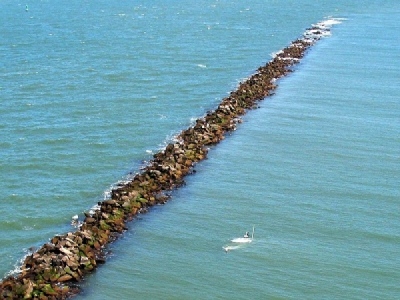
Posted on August 16, 2016
By Bo Petersen, The Post and Courier
The $550 million Charleston Harbor deepening project won’t move a grain of sand across the jetties. That continues to leave short the seriously eroding Folly Beach and Morris Island beaches.
The pair of 3-mile-long rock jetties extending like canal walls out of the harbor effectively block much of the north-to-south flow of sand in the near-shore currents that would feed those beaches, stripping Morris of an estimated 20 feet of beach per year and leaving the federal government on the hook to pay the bulk of the cost to periodically renourish Folly, a bill now more than $30 million per renourishment.
The Army Corps of Engineers did computer model runs and coastal morphology studies to look at options for moving some of that sand or allowing it to move through openings in the jetties as part of the project requirements. The corps concluded they would not be able to keep up with the dredging work, said district spokesman Sean McBride.
“We will continue to monitor it,” he said.
Proposals are still being considered to use dredging “spoils” from the project to shore up Morris Island, as well as the Crab Bank bird rookery and other nearby erosive spots. Costs and contamination are the biggest issues. The Army Corps plans to release an assessment of its findings and options this fall, McBride said.
Video: Most fascinating sealife in Africa
Folly Beach Mayor Tim Goodwin said he’s discussed with the Army Corps piling some of the spoils on the island’s side off the jetties, to allow the sand to work down to the beach, if it’s not contaminated. That sand eventually would flow toward Folly.
“We understand that pumping the sand from Sullivan’s Island is not cost-effective. You’re talking about a large pump running 24 hours a day,” he said.
The deepening project aims to dig the 45-foot-deep shipping channel to 52 feet from State Ports Authority terminals through the harbor to about the end of the jetties. It would give the state the deepest port on the East Coast, able to handle larger ships sailing the newly expanded Panama Canal.
The jetties won’t be reworked as part of the deepening.
The ports total economic impact on the state is about $53 billion, about 10 percent of the total annual gross economic product, and includes more than 187,000 jobs, according to a 2015 study.
The jetties could have been bypassed by pumping the sand through huge pipes underneath or onto barges to carry across, among other techniques that have been tried in other locations with mixed results. Both methods have issues and the chief one is cost, considered to be far more expensive than renourishing.
Source: The Post and Courier





